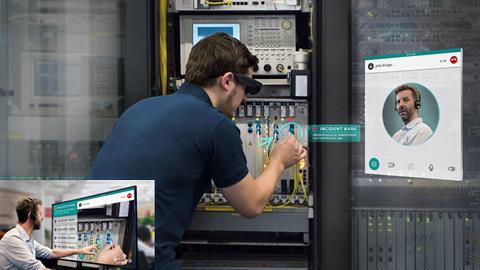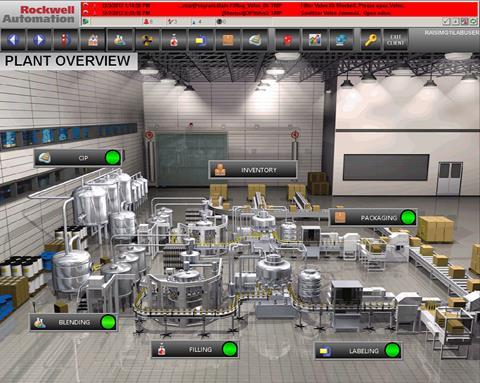
There’s an old adage for carpenters – measure twice, cut once. It is self-explanatory of course, an error in the cutting stage has much greater cost than an error in the measuring stage. But what if you could start cutting, finish cutting, complete assembly, test, adjust, and re-test, all without risk, and all in a matter of days? This is the world of the digital twin – writes Antoon Laane, Rockwell Automation’s product manager, Controllers & Design Software – EMEA region.
Put simply, for those not aware of the concept, a digital twin is an identical version of your machine, line, or plant that exists virtually. It’s hard to think of a single concept – at least one less nebulous than IIoT – which has such a far-reaching potential impact across industry than widespread use of digital twins. Naturally, it’s worth noting that digital twin technology both benefits from and offers benefits to IIoT and connected enterprise approaches, but it’s also a concept that can easily be understood on its own terms.
Sheer variety of use-cases
Since the advent of Computer Aided Design (CAD) the concept of creating fairly simple machines or designs in digital form before full prototyping is well understood. It’s a great starting point for visualising the digital twin concept, but the new twinning technologies available take the benefits much further, and to a far larger user-base.
Let’s stay with the design advantages of digital twins in the first instance. Original Equipment Manufacturers (OEMs) tend to be experienced with CAD. Traditionally, a design process consists of ‘building’ in CAD, followed by spending six months or more in R&D of the prototype iterations. Much of this time is spent finding and resolving issues. If the CAD product is brought into a digital twin environment – that is, inserted into a virtual plant in digital form, this whole process can be reduced to a couple of weeks. Moreover, once the original animation of the plant has been completed, the plans can be saved, so subsequent testing and prototyping can be even faster. Not only does the shortened design time and reduced prototype development (sometimes from seven prototypes down to two for a fully tested product) reduce cost, it also means that designers are able to create more machines or enhance existing machines much faster, reducing time to market and increasing market potential for the OEMs product portfolio.

But digital twin technologies are more than an evolutionary extension of CAD for machine designers and builders. One area that has taken an early lead in the application of digital twins is in materials handling. A typical application may have many conveying systems for automated storage and retrieval – an array of infeeds and outfeeds of varying lengths, roles and workloads. When building such a facility, or when refitting an existing one, it’s important to understand how many conveyance elements are required, and very useful to be able to run tests that explore different designs to optimise and simplify the plant. Using a digital twin in this instance allows engineers to see how a proposed system will work in practice, find bottlenecks, generate blueprints and even create code and operator HMI interfaces. Importantly, it can also help to identify where and how to position barcode readers for the track and trace applications which are prevalent in modern materials handling applications.
For Food & Beverage applications too, the benefits of digital twin technologies are manifold. Let’s take the example of a cookie manufacturer. Perhaps the marketing team has recognised that consumers in a certain country or region don’t buy packs of 24 cookies but want packs of 10 or 15 instead. Now, for a large manufacturer with 12 production lines, it’s highly likely that such requests for product variation are common – thus they are likely to have a line not working anywhere near capacity because it spends a significant proportion of time in prototyping – running variations at test stage – seeing how, for example, having lighter packages with just six cookies, run through the line. Learning what changes are necessary – catching the lighter packages when they are launched off the line by a conveyer running too fast for something so light. The advantage of the digital twin here is obvious; you can simulate packages of any size through the line – it might prove, in our simplistic example, that if there are sixteen cookies in the pack, it is heavy enough and no mechanical changes are needed to the lines. Not only can this be established quicker, with little or no product spoilage, but for every minute of testing on a digital twin, the manufacturer has all 12 lines producing saleable product.

With the best planning and intention, it is hard to know what will happen when a new machine or line is integrated into an existing system. Many nights of sleep are lost when downtime is planned for integration of a new machine or line, many more when things don’t go to plan and restarting the line is delayed. With a digital twin, this process can be much easier. Issues can be identified and resolved in the virtual world and the integration process can be practised and streamlined before shut-down. Moreover, operators can be trained to use the new line before it goes live, and with interesting applications of holographic virtual and mixed reality glasses, they could even walk around a digital twin and get familiar with how to operate and maintain it before it is even installed. Reducing risk, operator learning time and line shutdown time when marrying old with new is a fantastic example of the benefits of digital twinning that can be applied to almost any industrial environment.
I believe that just as the time has come when there’s virtually nothing that doesn’t start life as a CAD drawing, there will come a time when the use of digital twin technology applications will be virtually ubiquitous.











